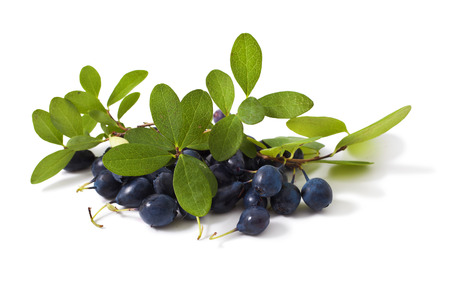Bilberry
 Bilberry (/ˈbɪlbəri/), also known as European blueberry, is a Eurasian low-growing shrub in the genus Vaccinium of the flowering plant family Ericaceae native to northern Europe and North America.[1][2] Vaccinium myrtillus L. is the species most commonly called bilberry, but other closely related Vaccinium species may also have this name.[1][3]
Bilberry (/ˈbɪlbəri/), also known as European blueberry, is a Eurasian low-growing shrub in the genus Vaccinium of the flowering plant family Ericaceae native to northern Europe and North America.[1][2] Vaccinium myrtillus L. is the species most commonly called bilberry, but other closely related Vaccinium species may also have this name.[1][3]
The plant produces edible, dark blue berries, which resemble – but are distinct from – North American blueberries.[2] The dark blue color of bilberries derives from the high content of anthocyanins.[1][2][4]
Well known in folklore, bilberry extracts and dried powders are sold as dietary supplements promoted mainly for eye disorders, although there is no substantial clinical evidence that consuming bilberry fruit or its preparations provides any health benefits.[2][4]
The name "bilberry" appears to have a Scandinavian origin, possibly from as early as 1577, while the earliest known English use of the name "blueberry" dates back to 1594, appearing in the Acts of Parliament of Scotland.[5][6] The name "bilberry" is similar to the Danish word bølle for whortleberry with the addition of "berry".[5][6] In Scandinavian languages, terms for bilberries have names with the meaning "blueberry", such as blåbär in Swedish and blåbær in Danish and Norwegian.[1]
The bilberry (especially Vaccinium myrtillus) may be called blaeberry /ˈbleɪbɛri/ in Scottish and Northern English regional dialects,[7] whortleberry /ˈhwɜːrtəbri/ in southern England,[7] and fraochán in Ireland.[8][9]
Bilberries, which are native to Europe, are different from North American blueberries, although the species are closely related and belong to the same genus, Vaccinium.[1][2]
Bilberries are non-climacteric berries with a smooth, circular outline at the end opposite the stalk, whereas American blueberries retain persistent sepals there, leaving a rough, star-shaped pattern of five flaps.[10] Bilberries grow singly or in pairs rather than in clusters, as American blueberries do, and American blueberries have more evergreen leaves. Bilberries are dark in color, and often appear near black with a slight shade of purple.[1][2]
Bilberries contain diverse polyphenols, including tannins, organic acids, phenolic acids, and anthocyanins, specifically anthocyanidins as delphinidin and cyanidin glycosides.[2][4][11][12] V. myrtillus bilberry pulp is red or purple, and V. uliginosum bog bilberry pulp is pale-colored.[citation needed] The high anthocyanin content of V. myrtillus may cause staining of the fingers, lips, and tongue.[11] The anthocyanin content of bilberries and bilberry juice may exceed the levels seen in blueberries and blueberry juice.[13]
The term bilberries can describe several closely related species, which (except for V. uliginosum) are part of section Myrtillus:[3]
Bilberry plants can suffer from bilberry blight,[14] caused by Phytophthora kernoviae. There have been severe outbreaks in Staffordshire, England.[15]
Bilberry is used as a food plant by the larvae of some Lepidoptera species.[citation needed]
Bilberries are found in acidic, nutrient-poor soils throughout the temperate and subarctic regions of the world.[1][2][4][3] Because they are difficult to grow and the fruit is small, bilberries are seldom cultivated.[1] Fruits are mostly collected from wild plants growing on publicly accessible lands throughout northern and central Europe where they are plentiful;[1] for example, up to a fifth (17–21%) of the land area of Sweden contains bilberry bushes, where it is called blåbär (lit. "blueberry", which is a source of confusion with the North American blueberry).[16] Bilberries can be picked by a berry-picking rake like lingonberries, but are more susceptible to damage.
In Iceland, bilberries (known as aðalbláber, or "prime blueberry") grow predominantly in Westfjords and the surrounding area.[17] In most of the country, the subtype bog blueberry occupies the same habitat. Both species are commonly found growing with dwarf birch and crowberries. Wild growth is vast compared to the population of Iceland and wild harvesting is legal, and a common activity in August when the berry season peaks.[citation needed]
In Ireland, bilberries (known as fraochán) were traditionally gathered on the last Sunday in July, known as Bilberry Sunday, for the Celtic harvest festival of Lughnasadh, which marked the end of the hungry month of July.[8][9][18]
The fruits are eaten fresh or made into jams, fools, juices, or pies.[1][2] In France and Italy, they are used as a base for liqueurs and are a popular flavoring for sorbets and other desserts. In Brittany, they are often used as a flavoring for crêpes. In the Vosges and the Massif Central, bilberry tart (tarte aux myrtilles) is a traditional dessert. In Romania, they are used as a base for a liqueur called afinată – the name of the fruit in Romanian is afină. In Nordic countries, they are eaten fresh or made into jams and other dishes, including bilberry pie (Finnish mustikkapiirakka, Swedish blåbärspaj) and blåbärssoppa, a bilberry soup served hot or cold. In Iceland, they are eaten with skyr (a cultured dairy product similar to yoghurt). In Poland, they are eaten fresh (often mixed with sugar), as a filling in a sweet yeast-leavened bun known as jagodzianka, in jams, and with śmietana.
Although bilberries have been used in traditional medicine, there are no proven health benefits or antidisease effects from consuming them.[2][4] One review of low-quality clinical research concluded there was no evidence that consuming bilberries improves night vision.[19]